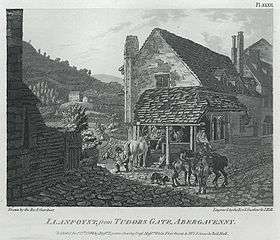Llanfoist
Llanfoist (Welsh: Llan-ffwyst) is both a village near Abergavenny, in Monmouthshire, Wales, and the community of Llanfoist Fawr. Llanfoist derives from Ffwyst, an early Christian Welsh saint, although the anglicised version of the church patron is Saint Faith. The population was 1,228 in 2011. [1]

The Church of St Faith
1901 Kelly's Directory of Monmouthshire describes the parish church of St Faith's:
"".. an ancient building of small dimensions, in the Gothic style, consisting of chancel, nave, south porch and a western bell gable with two bells" adding "The windows are stained; one on the south side, of three lights, was placed by Mrs. Wheeley in memory of her father. The east window and two small ones in the chancel were erected by the neighbouring gentry to the memory of Crawshay Bailey esq., the great ironmaster of Nant-y-glo, who is buried here. A three-light window on the north side was given by his tenantry as a memorial to the same. The chancel was restored in 1877 by Crawshay Bailey esq., son of the above, and since, deceased. There are 80 sittings. In the churchyard are two ancient yew trees, and an ancient stone cross."
The church holds records for baptisms from 1736–1975, for marriages from 1736–1971, for banns from 1824–47 and 1890–1933, and for burials from 1736-1945. There are also Bishops Transcripts for 1725-32, 1734–51, 1753-4, 1756–75, 1777–1806, 1808–10, 1813, 1815–16, 1820–37, 1841–58, 1862–1865, 1869 and 1880.
The parish of Llanelen has historically been held with Llanfoist, although since the retirement of the last resident Rector, the Reverend Thomas Arthur Foster (1923-2010) in 1992 the parishes have been served from Govilon (Llanwenarth Ultra).[2] At the time of his departure, Father Foster was the longest serving incumbent in the Diocese of Monmouth, having held the benefice since 1959. His predecessor, the Reverend Harold Stanley Richards (1888-1976) served between 1930-59.[3]
The village also had a Wesleyan Methodist Chapel, erected in 1839. In 1851 the attendance was 200 for morning worship (with 180 scholars), 200 scholars in the afternoon and 40 for evening worship with 50 scholars.[4]
Crawshay Bailey and Alexander Cordell
Llanfoist was home to the ironmaster, Crawshay Bailey. Before 1851 he had retired to Llanfoist House in the village. Llanfoist Primary School had a house named after him until 2008 when the House was renamed 'Skirrid'. He died in 1872, aged 83, after at least seventy years in industry. His only son and heir, also Crawshay Bailey (1841–1887), inherited his estate.[5]
The novelist Alexander Cordell, most famously author of Rape of the Fair Country is buried at Llanfoist.[6]
Amenities and attractions
The village is located beneath the hill known as Blorenge, part of the Brecon Beacons National Park, rising 1,838 feet (560 m) above sea level over the vale of the River Usk. The hill can be ascended on foot from Llanfoist, straight up its 'front', a very direct route but also very steep. The rewarding views from the top are among the best in South Wales.
The Monmouthshire and Brecon Canal runs just above the village[7] offering an excellent flat route for contour walking along the valley side, with views across to the Black Mountains. Llanfoist Wharf,[8] at a very picturesque location, a quarter of the way up the Blorenge, is now owned by a narrowboat hire company.
The village has a church hall, situated on the Merthyr Road, which holds Public Liability Insurance.[9]
Recent developments
The Llanfoist Fawr Primary School moved to a new location in the Barratt estate (Ffordd yr Ysgol) on Gypsy Lane and was opened in 2008.
On 2 January 2012 an ancient yew tree in the grounds of St Faith's Church, which was believed to be up to 1,000 years old, was brought down by high winds.[10]
References
- https://www.nomisweb.co.uk/reports/localarea?compare=W38000030
- Crockford's Clerical Directory, 2000-01, London, Church House Publishing.
- Crockford's Clerical Directory, 1973-74, OUP
- Jones. I. G., and Williams, D., (1976) The Religious census of 1851: A Calendar of the returns relating to Wales, Vol 1, South Wales. UWP, Cardiff.
- Jones, Alan (Spring 2005). "The 'Squire of Maindiff'". Gwent Local History (98): 53–62. Retrieved 26 March 2018.
- "In the footsteps of Alexander Cordell in South Wales" at literaturewales.org Archived 4 March 2016 at the Wayback Machine
- "Monmouthshire and Brecon Canal, near... (C) Pip Rolls". www.geograph.org.uk. Retrieved 26 March 2018.
- "Llanfoist wharf (C) RAY JONES". www.geograph.org.uk. Retrieved 26 March 2018.
- "MONMOUTHSHIRE VILLAGE HALLS". 7 January 2009. Archived from the original on 7 January 2009. Retrieved 26 March 2018.
- "'1,000 year-old' Llanfoist tree felled by gales". South Wales Argus. Retrieved 26 March 2018.
External links
| Wikimedia Commons has media related to Llanfoist. |